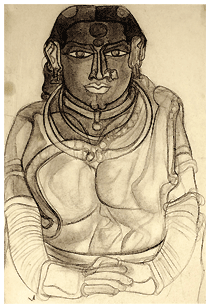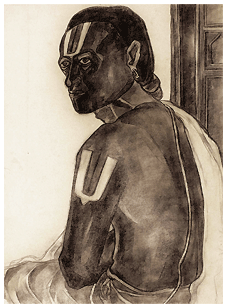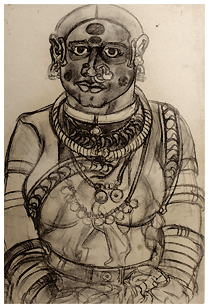- Prelude
- Guest Editor’s Column
- Hard Talk
- Digital Art
- The Write Stuff
- The Art of the Shakers : Shaker Furniture
- New Media
- In the News
- GenNext
- Report
- Artist Index and Statistics
- Market Insight
- Auction Reports
- The month that was
- Mumbai Artsighting
- Musings from Chennai
- Delhi Dias
- Deccan Odyssey
- Art Bengaluru
- In between – from Vadodara
- North-East Opsis
- A Tryst with Art in Madhya Pradesh
- Strands of Social Semiotics
- Transcending Popular
- Art of the Land & Land in Art (part I)
- Through The Patina
- Earth
- Go See India
- Dali's Elephant
- Malleable Memory
- Creative Impulse
- Different hues of Aakriti
- Bonhams : Fine Writing Instruments New York
ART news & views
Deccan Odyssey
Volume: 2 Issue No: 7 Month: 8 Year: 2010
Early works of Thota Vaikuntam 1971 to 1984
Indian modernism has taken in many subjective routes. Consequently, Modern Art in India is consociated with an abundance of content, language and approach. Indian Art is contemporarized with the arrival of contexts of personal encounters, social narratives and concerns related to identity, wherein contextualization and definition of each element, plays a very important role, to corroborate to the term 'contemporary'.
The socio-political milieu in India is sharply mirrored in images reflecting fragmentation, consumerism, globalization and their meta-narrations.  Parallel to this, Thota Vaikuntam's work has emerged with an emblem, navigating three intersections i.e., local consciousness at the contextual level, emotional response to his personal history and an intense merging of Indian traditional intention with western academic skill in terms of execution.
Parallel to this, Thota Vaikuntam's work has emerged with an emblem, navigating three intersections i.e., local consciousness at the contextual level, emotional response to his personal history and an intense merging of Indian traditional intention with western academic skill in terms of execution.
A very important phase of Vaikuntam's creative vision is brought to light here. During this time, Vaikuntam was living in Boorugupalli, taking care of his mother and making small drawings in his free time. These drawings are of almost everything that caught his eye, be it people, victuals, doors, tools, his mother's utensils and belongings. Some drawings are an intense study of these elements. A few of them are casual sketches and the rest are spontaneous compositions. The range of work throws light on the gradual transition from factual depiction to development of a responsiveness that culminated into a new motif representing formal aesthetics, a way of life and history. This motif is a poignant contribution to Indian Art; to reflect the consolidation of the image of a rural people in India. Seen in this sense, the work is Vaikuntam's version of saying, 'we are like that only'.
Acknowledging the roots of his art, Vaikuntam says, “All I know is what the village gave me, the music, the folklore, song, dance and poetry.” The spiritualization of his village folk, in his images, is strikingly singular in its manifestation. This has had a deep impact in the work of a few young artists working in and around Hyderabad, and has certainly caused the Telangana School to come to fruition. This School is not consequential to a pedagogic cause nor is it specific to contemporary Telangana issues in the political context. Rather, it has evolved due to an inspirational use of a rhetoric that specifically mentions a certain region, its people and culture. Vaikuntam's mention of Boorugupalli's people through his drawings and sketches is singularly nurtured by means of culture-specific nationalism with reference to his time and his own personal considerations.
In Vaikuntam's art, the lives of people surface by means of the iconography of the people he draws, their attire, ornaments and the victuals they carry, the culmination of observation and absorption of ritual and customs, physiognomy and body language.  The mention of Telangana occurs repeatedly, in the context of Vaikuntam's origin and growth, his past, the time he spent taking care of his mother and internalizing his surroundings.
The mention of Telangana occurs repeatedly, in the context of Vaikuntam's origin and growth, his past, the time he spent taking care of his mother and internalizing his surroundings.
Thota Vaikuntam, through his art, evokes the master artists of Khajuraho, Konark, Ajanta, the goldsmiths, and the weavers, the temple rituals, Nihalchand's Bani Thani of Kishangarh, Gauguin, Cezanne, Pissarro, Brancussi, the master craftsmen of Anantapur, those of Nakashipatam, the performers of Kuchipudi and Yakshagana. He chose to walk the middle path between western and Indian knowledge, between past and present, between tradition and modernity. His successful arbitration of all these, moved his practice in a different direction, contrary to that of the popular progressive artists and their existing influence.
This list does not credit influences to the works of Vaikuntam. Artists as inspired entities are a universal phenomenon. What artists essentially take from other artists is a combination of ideas, elements, techniques and attitude. The list is but a pointer to the culture Vaikuntam's works represent.Vaikuntam is not a regionalist by intent; his imagery may well be constituted of a locational idiom. What registers in a big way is his adaptive and integrative method and transcendental attributes that render it truthful to Indian Art and broaches the rhetoric of an ethnic nationalism.
Culture is a natural and an open ambience that allows cerebral, creative and scholarly minds to dissociate from a conventionally generalized identity and connect with their specific local and provincial selves. There is not only a structural affinity between Thota Vaikuntam and Jamini Roy's compositional extension of the image, but also an interesting similarity in the way both artists, belonging to different period zones and regions, have reflected their idea of the locale as the site within the nation. The epistemology that the most intimate connection of the individual is with his soil, finds expression in the work of both the artists; bringing back the mention of the agrarian community in the life of the alienated urban individual. The conveyance to arrive at this notion was different for both the artists. Jamini Roy's vehicle is that of his advanced Marxist notions whereas for Vaikuntam it is a matter of nostalgia and its reflection in an urbanized India.
While use of the term nostalgia lugs a sense of discomfort, its reflections appear much more frequently in Contemporary Indian Art than the willingness to discuss it. Like every other word 'nostalgia' has meaning and history specific to it.
Vaikuntam's appropriation of the abstractionist's language of multitudinous planar arrangements with an intention to enhance the narrative quotient in his depiction is reflected in the portrayal of the Brahmin with multiple eyes and nose; this reports a sense of  confusion in the image of the Brahmin priest seeking information from multiple directions. Portrayals of men and women not only reflect his engagement in playing with multiple planes and their shifts but also coalesce his knowledge of traditional leather and cloth puppet making, and its formation in parts. This innovative amalgamation attributes theatricality and movement to his drawings and calls forth the notion of Gestalt. The thoroughly outlined physical motivation of form in Vaikuntam's works, gives rise to a unitary image as well as an articulated figure with different parts, which favour both unity and articulation.
confusion in the image of the Brahmin priest seeking information from multiple directions. Portrayals of men and women not only reflect his engagement in playing with multiple planes and their shifts but also coalesce his knowledge of traditional leather and cloth puppet making, and its formation in parts. This innovative amalgamation attributes theatricality and movement to his drawings and calls forth the notion of Gestalt. The thoroughly outlined physical motivation of form in Vaikuntam's works, gives rise to a unitary image as well as an articulated figure with different parts, which favour both unity and articulation.
His drawings are constructed by distinct delineation of each plane. His planes are not constructed by strokes, unlike a cubist plane they are defined by rhythmic lines. Each plane has its own identity. In his later work of spontaneous drawings, the structural quality diminishes and becomes intensely massive. Pertaining to the rhetoric of the part and the whole the mass then becomes a congregation of flattened planes. These planes are portions of the entire representation of the human body. He perceived them in entirety and achieved a totality through painstaking observation of the parts that constitute it. The lines are controlled and deep.
These intensely determined lines are sensitive enough to recall the real person.
The transition from the existent to a formation of the triumphant motif was gradual. An overture of rhythm, simplification and recurrence play a vital role in turning over Vaikuntam's academic studies, to an idiom with an astute Indian sensibility. This change had set in gradually, resulting from a regular discipline of practice and recognition of his ingenuity.
Vaikuntam is simply inspired by the tradition of his native state; he lives in a moment in time that juxtaposes the indigenous with the contemporary. In the precinct of Indian Art, for decades, pursuing the Indian tradition was posited alongside the idea of imbibing western expressions. Juxtapositions such as this, would raise questions like “what is Indian in our art?” This conscious yearning for Indian-ness in art both in expression and in content stems from a historical phenomenon linked to India's colonial history and independence. This pattern perhaps was reflected in Vaikuntam's Art college classroom as well; in Raghottam Rao's advice to be cognizant of ones national identity.
An article published in a magazine intrigued him the most; it discussed the identity of India and its expression in culture, philosophy and celebrations. As he mulled over the writing, he was brought face to face with his personal search to arrive at an expression of his own, bearing reflections of himself, as an artist, as a person, of his, locale and culture.  Vaikuntam's simplicity in revisiting his village happened due to certain responsibilities but his intention of reclaiming it internally and pictorially is apparent in his work.
Vaikuntam's simplicity in revisiting his village happened due to certain responsibilities but his intention of reclaiming it internally and pictorially is apparent in his work.
Some of the charcoal sketches and drawings on paper happened between 1982 and 84, the people depicted in these sketches and studies are from Vaikuntam's village. These portrayals were of Brahmin priests, folk performers, farmers, laborers, neighbors, familial relations, men and women of all ages and all occupations. It was a necessity for Vaikuntam to go through the rigorous exercise of seeing and rendering to perfect the skill to draw from life and comprehend people, their body language, and expression. Later on, these drawings served as references for his compositions. Even though Vaikuntam sketched these 'on-the-spot', he would compose them well on the paper. Vaikuntam's preference to sketch a bust, a profile, the three fourth of the upper body or a frontal portrait, served an internal aesthetic requirement of having a satisfying composition.
Boorugupalli's saga unfolds in clear depictions, of the Dorah the village head, the Dorahsani, his wife and his men the Palerlu, the Sunkarlu and Bundigada, the strong cobbler who lived a hundred years, always engaged in making ropes, shoes and when there was no work he played music. The wealthy money lender known as Seth, with his impeccable Topi and Dhoti-Kurta, The lady expressing anguish to her pet parrot, they are definite characters each empowered with a potential narrative. “I am aware of them as I am a part of them says” Vaikuntam.
He drew the women going for Bathkamma a festival of the pre-monsoon ritual. Seated women watching over, thronging in groups, talking. Vaikuntam says, “They are not beautiful but they are lovely people, warm, robust and spontaneous. Not everyone in the villages is poor either, the way of life there is different, people wear clothes according to the weather, and every thing is according to their needs, the food their huts and their tools”. The work titled 'Village Song' is a rhythmic line drawing of all kind of tools used by people of all castes and occupation. The tools represent the entire village, the people and their work.
Thus, all the personas are summoned, they appear and with them emerges a tale usual and yet special, seen and remembered by the artist. He is apprehensive of the change that has crept up on the villages in contemporary India. The shopping malls in the Indian metropolis reflect the contemporary time as much as the fazing out of the bucolic does.
Vaikuntam has meticulously drawn the portraits and expression of the people and with the same sincerity; he attends to the folds of the drapery, the animals accompanying the people, the ornaments and the design of the coiffure.
A selection of the spontaneous line drawings clearly brings to light, the emergence of a motif, of composite information, integrating within it, many essentials. A motif that evokes Boorugupalli and its people.
Created by lines and tones, these planes determine a sense of structure of specific people. The nomenclature of these works is a balance between a decorative two-dimensionality and a structural three-dimensional quality. In most of these drawings, the stress of the lines and definite tones alone has given full expression to the artist's version of reality.
In Tirupati, he saw thousands of people in procession, crying out “Govinda”. Unified in one calling, they had forsaken their individuality and self-importance. His experience at the cultural concerts were also rewarded by rich visual stimulation, he observed the performers, A few of his teachers were dancers, they used to talk about how hands play a very important role, how Mudras were integrated in the dance form from people's gesticulation to communicate.  Vaikuntam would capture the movements of people, their shift of posture in his drawings; this attributed a sense of continuation in the form and a multiplicity in its dimension.
Vaikuntam would capture the movements of people, their shift of posture in his drawings; this attributed a sense of continuation in the form and a multiplicity in its dimension.
The drawings have an inimitable permutation of proportion and harmony. The artist's observation of his subjects is revealed through the accentuated shape of the eyes, dimensionality of the lips, the curvaceous back, the portliness of a human body, the protrusion of bloated belly and the suspended mass of the breast forming an awkward curve, convincingly adapt to a rhythmic vitality. The study is carried out from the knowledge of a long distance, western academic, art historical tutelage acquired from seeing plates but its transference through rhythm and apparent simplicity conveys an acute traditional Indian sensibility. The liaison between beauty, art and things that are natural are ironic, because even though the beauty of Nature is thought of as an ideal it is considered that art could portray all that is natural, beautifully. (Even when Nature depicted was in itself hazardous or bizarre.) The phenomenon of Vaikuntam's images call to mind the phenomenon of beauty in the ordinary.
Over time, as his expressions gained maturity, a sense of stillness and objectivity pervaded the rhythmic play of lines and tones. This achievement of equilibrium transformed the ordinary people to mystic embodiments of graciousness.
These undisclosed works find Vaikuntam in a novel involvedness. The intelligence of totality and the purpose of finding pleasure in successful labor that Vaikuntam's works radiate bring to mind the writer, designer and campaigner, William Morris. Morris however had given up painting but the patterns and flourishes he drew and the complexities of form and embellishments in his creations were derived from all that existed naturally. Morris's belief that all art was narrative as it told a story of culture and the story of its maker is appropriate in the context of Vaikuntam's image making. In depicting the men and women their tools objects and elements, Vaikuntam takes into account the manner in which people wore clothes, their various responsibilities and activities as householders. Nothing went amiss. The strong play of light on human skin, the human body as a site of union and the day-to-day goings-on in his village, were projected with such clarity that even the tools and utensils that he depicted, communicate the standards of beauty and usability held by the craftsmen. The final emergence in his art is a mythical growth fed by the creative spirit of the artist.